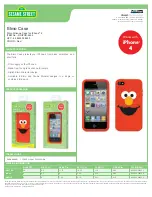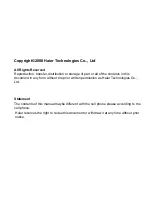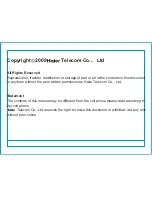
Section 15
Knowing Performance and Safety Guidelines
103
Per
for
m
anc
e
an
d Saf
e
ty
15
Although the existing scientific data do not justify FDA regulatory actions at this time,
FDA has urged the mobile phone industry to take a number of steps to assure public
safety. The agency has recommended that the industry:
÷
support needed research into possible biological effects of RF of the type emitted
by mobile phones;
÷
design mobile phones in a way that minimizes any RF exposure to the user that
is not necessary for device function; and
÷
cooperate in providing mobile phone users with the best possible information on
what is known about possible effects of mobile phone use on human health.
At the same time, FDA belongs to an interagency working group of the federal
agencies that have responsibility for different aspects of mobile phone safety to ensure
a coordinated effort at the federal level. These agencies are:
÷
National Institute for Occupational Safety and Health
÷
Environmental Protection Agency
÷
Federal Communications Commission
÷
Occupational Health and Safety Administration
÷
National Telecommunications and Information Administration
The National Institutes of Health also participates in this group.
In the absence of conclusive information about any possible risk,
what can concerned individuals do?
If there is a risk from these products—and at this point we do not know that there
is—it is probably very small. But if people are concerned about avoiding even
potential risks, there are simple steps they can take to do so. For example, time is a
key factor in how much exposure a person receives. Those persons who spend long
periods of time on their hand-held mobile phones could consider holding lengthy
conversations on conventional phones and reserving the hand-held models for
shorter conversations or for situations when other types of phones are not available.
People who must conduct extended conversations in their cars every day could switch
to a type of mobile phone that places more distance between their bodies and the
source of the RF, since the exposure level drops off dramatically with distance. For
example, they could switch to
÷
a mobile phone in which the antenna is located outside the vehicle,
÷
a hand-held phone with a built-in antenna connected to a different antenna
mounted on the outside of the car or built into a separate package, or
÷
a headset with a remote antenna to a mobile phone carried at the waist.
Again, the scientific data does not demonstrate that mobile phones are harmful. But
if people are concerned about the radiofrequency energy from these products, taking
the simple precautions outlined above can reduce any possible risk.
Where can I find additional information?
For additional information, see the following websites:
÷
Federal Communications Commission (FCC) RF Safety Program (select
“Information on Human Exposure to RF Fields from Cellular and PCS Radio
Transmitters”): http://www.fcc.gov/oet/rfsafety
Summary of Contents for 2345
Page 1: ...Sprint PCS The clear alternative to cellular SM ...
Page 8: ......
Page 10: ......
Page 16: ...Section 2 8 Getting to Know Your Sprint PCS Phone 2 Getting to Know Your Sprint PCS Phone ...
Page 40: ......
Page 50: ......
Page 58: ......
Page 70: ......
Page 74: ......
Page 82: ......
Page 90: ......
Page 102: ......
Page 128: ......















































